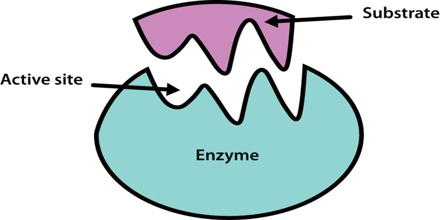
What is the molecule on which an enzyme acts?
Answer
428.1k+ views
Hint: Enzymes are proteins that act as the catalyst in our bodies. These proteins are responsible for setting off physiological reactions in the body. For example, amylase is the enzyme that binds to certain molecules in starch and breaks it down.
Complete answer:
The molecule that the enzyme binds to is known as a substrate. The enzyme and the substrate fit together like jigsaw puzzle pieces. Thus when it is time for the substrate to be broken down, the enzyme gets released. The enzyme must fit into the active site of the substrate in order to set off the reaction.
For example, when we eat food that contains starch, our mouth starts to salivate. The saliva that we hold contains amylase which is an enzyme that breaks down starch. When the amylase is released, it is attached to the starch molecule and breaks it down into simpler molecules which can then be used to produce energy.
If the shape of this substratum is changed in some way then the enzyme cannot bind to it. Thus the enzyme isn’t able to work and gets inhibited. This is how the action of enzymes gets inhibited.

Note:
Enzymes bind to substrates in order to set off their reactions. In order for an enzyme to work, it must bind to the active site of the enzyme. If another molecule binds to the substrate and changes its conformation it will inhibit the enzyme and thus the process will not work.
Complete answer:
The molecule that the enzyme binds to is known as a substrate. The enzyme and the substrate fit together like jigsaw puzzle pieces. Thus when it is time for the substrate to be broken down, the enzyme gets released. The enzyme must fit into the active site of the substrate in order to set off the reaction.
For example, when we eat food that contains starch, our mouth starts to salivate. The saliva that we hold contains amylase which is an enzyme that breaks down starch. When the amylase is released, it is attached to the starch molecule and breaks it down into simpler molecules which can then be used to produce energy.
If the shape of this substratum is changed in some way then the enzyme cannot bind to it. Thus the enzyme isn’t able to work and gets inhibited. This is how the action of enzymes gets inhibited.

Note:
Enzymes bind to substrates in order to set off their reactions. In order for an enzyme to work, it must bind to the active site of the enzyme. If another molecule binds to the substrate and changes its conformation it will inhibit the enzyme and thus the process will not work.
Recently Updated Pages
The correct geometry and hybridization for XeF4 are class 11 chemistry CBSE

Water softening by Clarks process uses ACalcium bicarbonate class 11 chemistry CBSE

With reference to graphite and diamond which of the class 11 chemistry CBSE

A certain household has consumed 250 units of energy class 11 physics CBSE

The lightest metal known is A beryllium B lithium C class 11 chemistry CBSE

What is the formula mass of the iodine molecule class 11 chemistry CBSE

Trending doubts
Why was the Vernacular Press Act passed by British class 11 social science CBSE

Arrange Water ethanol and phenol in increasing order class 11 chemistry CBSE

Name the nuclear plant located in Uttar Pradesh class 11 social science CBSE

One Metric ton is equal to kg A 10000 B 1000 C 100 class 11 physics CBSE

What steps did the French revolutionaries take to create class 11 social science CBSE

How did silk routes link the world Explain with three class 11 social science CBSE




